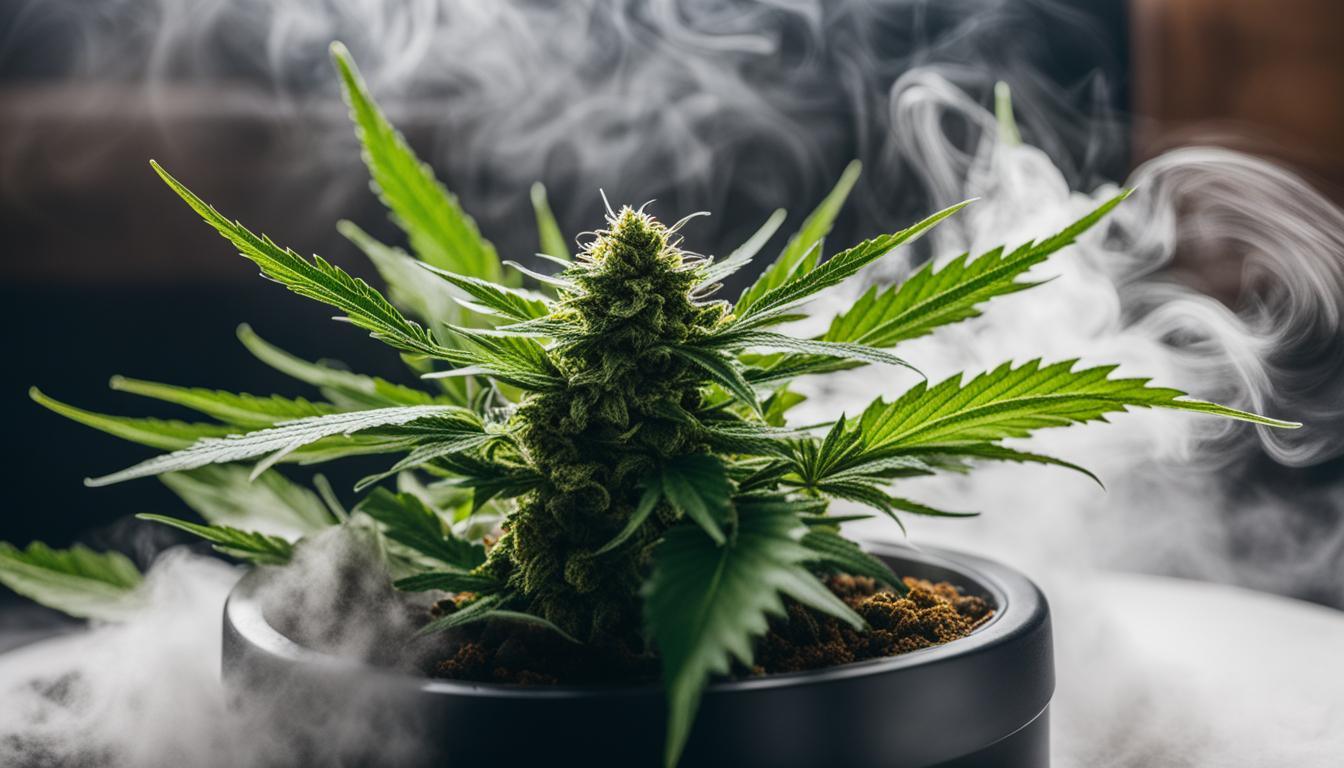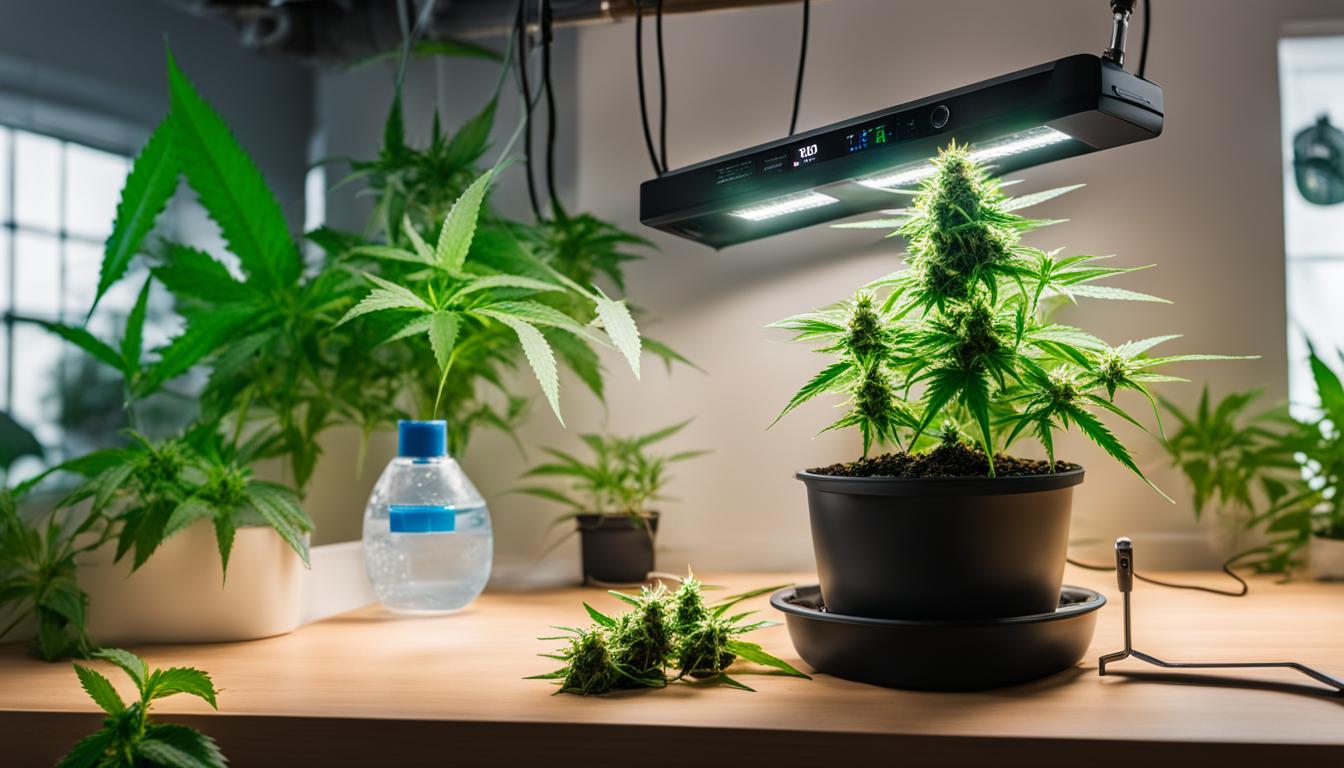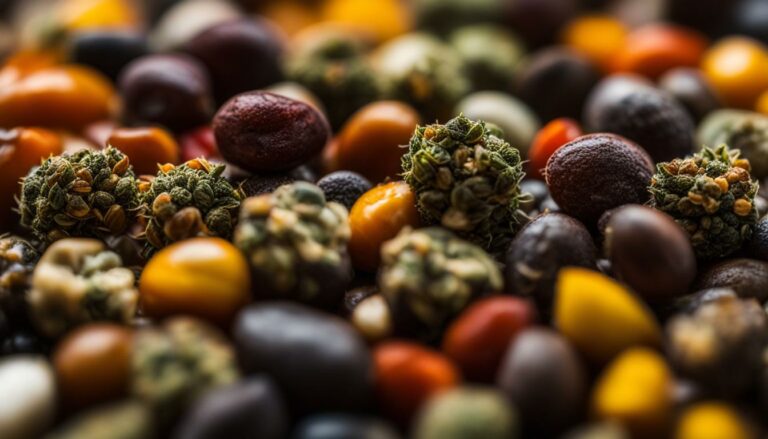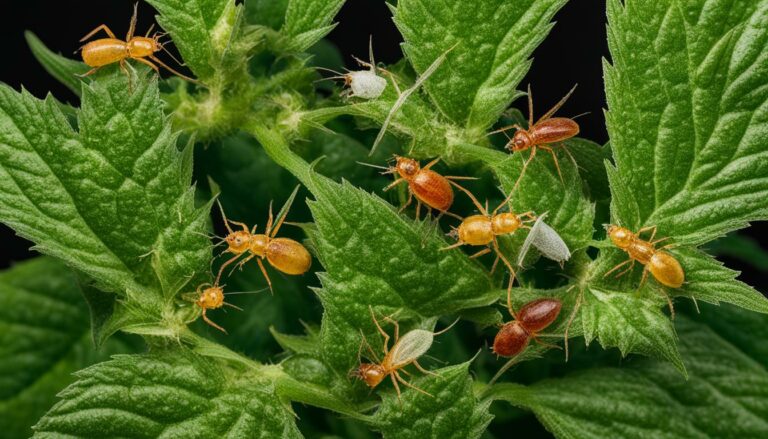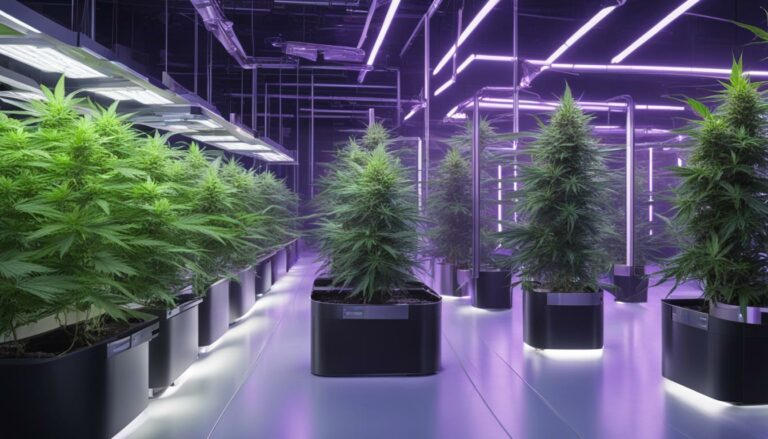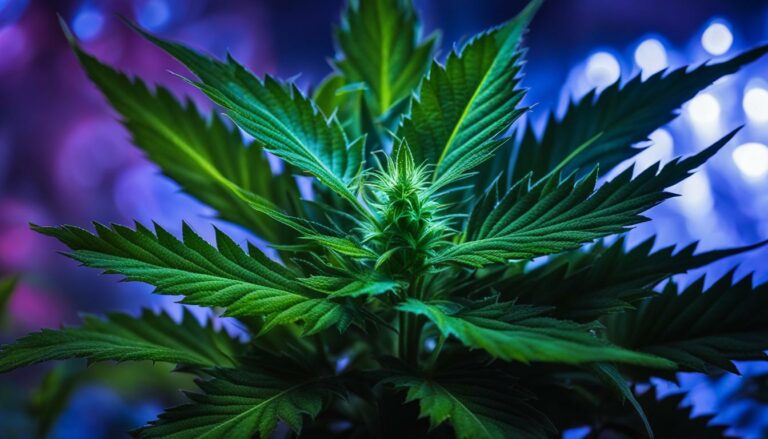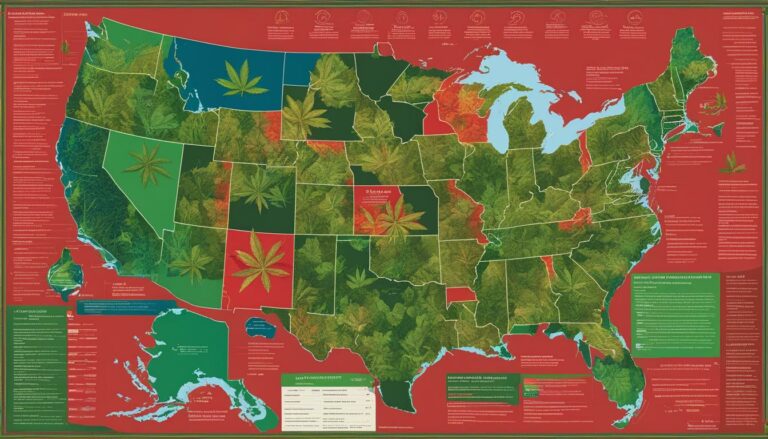How to Cure Cannabis for Optimal Potency
Curing cannabis is an art that elevates the cultivation process to new heights, ensuring the production of superior buds. As the final step before consumption, proper curing is crucial in unlocking the full potential of your cannabis harvest. By following the best practices for curing cannabis, you can enhance the potency, aroma, and flavor of your buds, resulting in an exceptional smoking experience.
To achieve optimal results, it is essential to create the perfect environment for your cannabis to cure. The process involves carefully controlling humidity, temperature, and darkness to preserve the precious cannabinoids, terpenes, and other compounds that give cannabis its distinctive qualities.
In this article, we will explore the cannabis curing process in detail, including the optimal curing conditions and techniques for achieving the best results. We will also discuss the importance of proper drying before curing and the benefits of a well-executed curing process.
If you are ready to unlock the full potential of your cannabis harvest and discover how to cure cannabis properly, then let’s dive in!
Why Curing Cannabis Is Important
Curing cannabis is considered crucial in the cultivation process for several reasons. It plays a vital role in retaining cannabinoid levels, ensuring the maximum potency of THC or CBD in the buds. Proper curing also helps control and maintain the moisture content throughout the bud, resulting in a more consistent product.
During the curing process, the breakdown of primary metabolites, such as sugar and chlorophyll, occurs. This breakdown leads to a smoother smoking experience, reducing any harshness associated with poorly cured buds. Additionally, curing cannabis preserves the delicate terpenes responsible for the distinct aroma and flavor profiles of the bud.
“Proper curing helps retain cannabinoid levels, controls moisture content, and preserves terpenes, resulting in potent, flavorful, and enjoyable cannabis buds.”
“The art of curing cannabis is the key to unlocking its full potential. It’s like aging a fine wine; patience and attention to detail yield remarkable results.”
The Key Benefits of Curing Cannabis:
- Retains cannabinoid levels for maximum potency
- Maintains consistent moisture content throughout the bud
- Breaks down sugar and chlorophyll, resulting in a smoother smoking experience
- Preserves the delicate terpenes responsible for aroma and flavor
By understanding the importance of curing cannabis, cultivators can ensure that their buds reach their full potential, delivering an exceptional experience for consumers.
| Benefits of Proper Curing | Cons of Poor Curing |
|---|---|
| Enhanced potency, flavors, and aromas | Harsh taste and reduced potency |
| Improved consistency and shelf life | Increased risk of mold and degradation |
| Preservation of terpenes for a diverse sensory experience | Loss of terpenes and limited terpene profile |
The Optimal Conditions for Curing Cannabis
When it comes to curing cannabis, maintaining the optimal conditions is crucial for achieving the best results. The right environment ensures the preservation of cannabinoids, terpenes, and overall bud quality. Here are the key factors to consider:
- Humidity Levels: Keeping the humidity between 50%-60% is essential during the curing process. This range provides the ideal balance to prevent mold growth while allowing the buds to dry properly.
- Temperature: A temperature of 60°-70° F (15.5°-21°C) is recommended for curing cannabis. This moderate and consistent temperature helps retain the potency and aroma of the buds.
- Storage Containers: Opt for airtight containers, such as glass jars or ceramic containers, to create the perfect curing environment. These containers help maintain a stable humidity level and prevent light degradation.
- Darkness: Protecting the buds from light exposure is crucial during the curing process. Light can degrade cannabinoids and alter the flavor of the buds, so it’s important to store them in a dark place.
By ensuring these optimal conditions, you can maximize the potency, aroma, and smoothness of your cannabis buds. The curing process takes time and patience, but the results are well worth it. Now let’s take a look at a table summarizing the optimal curing conditions for cannabis.

In Summary
Proper curing conditions are crucial for achieving the highest quality cannabis buds. Maintaining humidity levels between 50%-60%, a temperature of 60°-70°F (15.5°-21°C), using airtight storage containers, and storing the buds in a dark place are the key elements for successful curing. By following these optimal conditions, you can enhance the potency, flavor, and overall experience of your cannabis.
Drying Cannabis Prior to Curing
Before beginning the curing process, it is necessary to dry the cannabis buds. This step helps remove excess moisture and sets the stage for a successful cure. There are two common methods for drying cannabis: wet trimming and dry trimming.
Wet Trimming
Wet trimming involves trimming the buds immediately after harvest. This method is popular among growers who prefer a quicker drying process. After harvesting the plants, the buds are carefully trimmed, removing any excess leaves. Wet trimming can help prevent the development of mold and mildew, as the excess foliage is removed, allowing for better airflow. However, it’s important not to trim too much, as the sugar leaves provide protection and contribute to the overall flavor and aroma of the final product.
Dry Trimming
Dry trimming, on the other hand, involves allowing the buds to dry before trimming. This method is often preferred by growers who believe it preserves the integrity of the trichomes and leads to a more flavorful end product. After harvest, the plants are hung upside down in a cool, dark room with proper ventilation. Once the buds have dried to the desired moisture content, they are carefully trimmed to remove excess foliage. Dry trimming can be more time-consuming, but many enthusiasts believe it produces a higher-quality end product.
Regardless of the chosen method, it’s important to ensure that the buds are dried in a dark room with a temperature of around 60°F and humidity levels between 55-60%. Proper drying not only prepares the buds for the curing process but also helps prevent the growth of mold and mildew, ensuring a safe and enjoyable end product.
| Wet Trimming | Dry Trimming |
|---|---|
| Trimming immediately after harvest | Allowing the buds to dry before trimming |
| Quicker drying process | Preserves trichomes and flavor |
| Helps prevent mold and mildew | Can be more time-consuming |
Cannabis Drying and Curing Methods
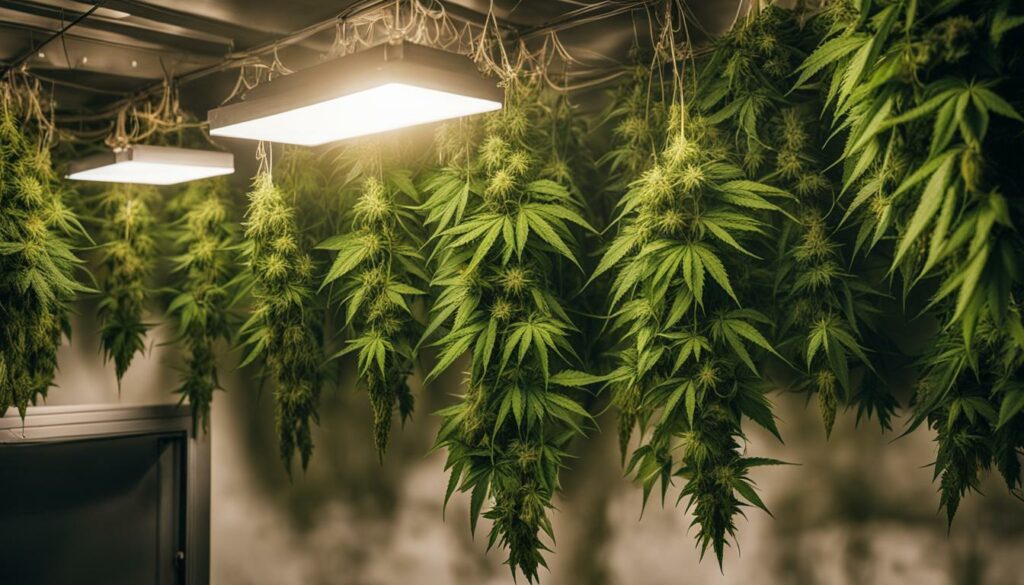
Cannabis drying and curing are essential steps in the cultivation process to ensure the highest quality buds. Proper drying and curing methods not only enhance the aroma, flavor, and potency of the cannabis but also contribute to its overall longevity. By employing the right techniques, growers can achieve optimal results and provide consumers with a superior product.
The Importance of Proper Drying
Before the curing process can begin, it is crucial to properly dry the cannabis buds. This involves hanging the plants upside down in a cool, dark, and well-ventilated area. Maintaining a temperature of around 60-70°F and humidity levels between 55-66% creates the ideal environment for drying.
While the drying process typically takes between 3-10 days, it is important to monitor the buds closely. A helpful technique to determine if the buds are fully dry is the “Branch Bending Test.” If the stems snap instead of bending when gently bent, the buds are considered dry and ready for the next stage of curing. Patience is key, as a slow and thorough drying process often results in enhanced flavors and aromas.
The Process of Hanging Drying
Hanging the cannabis plants upside down is the most common method for drying the buds. This method allows for better air circulation around the plants, preventing the growth of mold or mildew. The plants should be hung in a location with a controlled temperature and humidity levels to ensure consistent drying.
During the hanging drying process, it is important to regularly check the buds for any signs of mold or excess moisture. If any issues are detected, adjustments should be made immediately to prevent further damage to the crop. Once the buds have dried completely, they are ready to be moved on to the curing stage.
The Cannabis Curing Process
| Curing Method | Process |
|---|---|
| Jar Curing | The dried buds are placed loosely in airtight containers, such as glass jars, and stored in a cool, dark place. |
| Auto-Curing Buckets | For larger-scale operations, food-grade, airtight containers with air pumps are used for controlled curing. |
Proper curing requires patience and attention to detail. By following the correct methods and maintaining optimal conditions throughout the drying and curing process, growers can produce cannabis buds that are rich in aroma, flavor, and potency.
The Process of Jar Curing Cannabis
Curing cannabis buds in jars is a popular and effective technique that allows for optimal flavor, aroma, and potency development. Once the buds have been dried and trimmed, they should be placed loosely in airtight containers, such as glass jars, that are filled about three-quarters full. The jars should then be stored in a cool, dark place with humidity levels between 55-65%. This controlled environment allows for the gradual breakdown of sugars and chlorophyll while preserving the delicate terpenes.
During the first week of jar curing, it is important to “burp” the jars. This involves opening them once or twice a day to release excess moisture and replenish oxygen. This process helps to prevent mold growth and ensures a proper curing process. After the initial week, the jars can be opened every few days to continue monitoring and adjusting the humidity and temperature levels. It is crucial to maintain humidity levels between 55-65% to prevent moisture-related issues.
Jar curing typically takes a minimum of two weeks, but some cannabis enthusiasts prefer to extend the process for up to several months to enhance the flavors and aromas further. During this time, the buds should be periodically checked for mold or excessive moisture. If any signs of mold or mildew are detected, the affected buds should be removed immediately to prevent contamination of the rest of the batch.
Benefits of Jar Curing Cannabis:
- Enhanced aroma, flavor, and potency development
- Gradual breakdown of sugars and chlorophyll
- Preservation of delicate terpenes
- Controlled environment for gradual curing
Overall, jar curing cannabis allows for the optimal development of flavor, aroma, and potency by providing a controlled environment that gradually breaks down unwanted compounds while preserving the desired ones. It is a technique that requires patience and attention to detail but ultimately results in a high-quality end product for cannabis enthusiasts to enjoy.
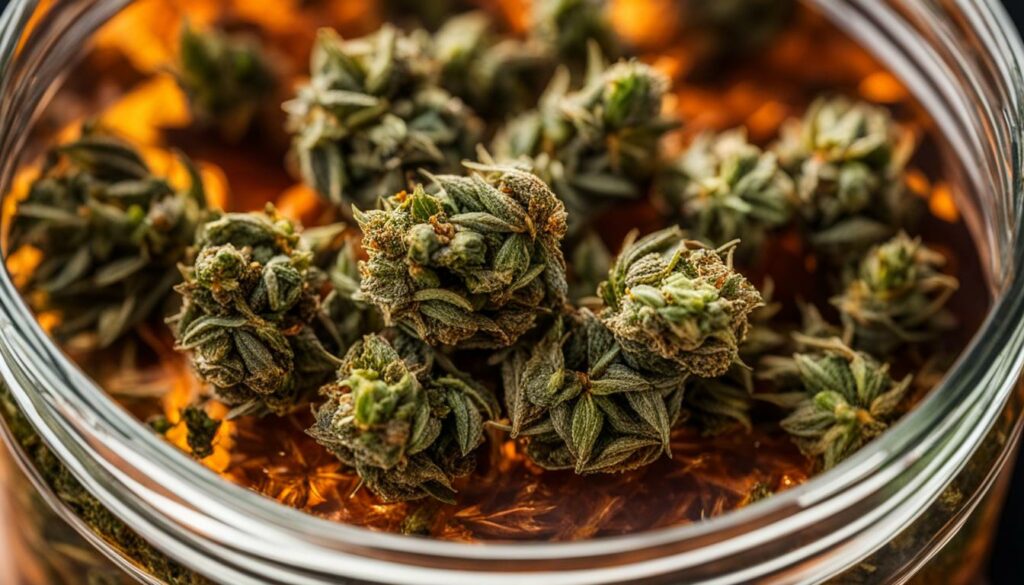
The Importance of Monitoring Humidity and Temperature
Proper monitoring of humidity and temperature is essential during the cannabis curing process to ensure optimal conditions for the buds. Humidity levels should be maintained between 45-65%, while the temperature should be around 21°C/69.8°F. Monitoring these factors allows for a controlled curing environment that promotes the desired chemical reactions within the buds.
Using a hygrometer is recommended to accurately measure the humidity levels in the curing room or containers. This device provides real-time data, allowing growers to make necessary adjustments if the humidity levels rise above the optimal range. If the humidity exceeds 65%, it is advisable to leave the curing jars open for a period of time to lower the humidity.
Temperature control is equally important in maintaining the quality of the cured cannabis. By keeping the temperature around 21°C/69.8°F, the buds undergo the intended biochemical changes without risking degradation or mold growth. Monitoring both humidity and temperature throughout the curing process ensures that the buds are exposed to the optimal conditions necessary for achieving the desired potency, flavor, and aroma.
The Impact of Humidity and Temperature on Curing Cannabis
The levels of humidity and temperature directly impact the curing process and play a vital role in preserving the quality of the cannabis buds. When humidity levels are too high, the buds may develop mold and mildew, leading to potential health risks and a compromised product. Conversely, low humidity levels can cause the buds to dry too quickly, resulting in a harsh and unpleasant smoking experience.
Proper monitoring of humidity and temperature is crucial during the curing process to maintain the ideal conditions for the cannabis buds, allowing them to develop their full potential in terms of flavor, potency, and aroma.
Similarly, temperature fluctuations can affect the curing process. Higher temperatures can accelerate the breakdown of terpenes and cannabinoids, leading to a loss of aromatic compounds and reduced potency. On the other hand, colder temperatures can slow down the curing process, prolonging the time it takes for the buds to reach their optimal state.
By diligently monitoring and controlling the humidity and temperature, growers can ensure that their cannabis buds undergo a consistent and successful curing process, resulting in a premium product with enhanced quality and long-term shelf life.
Summary
Monitoring humidity and temperature is of utmost importance during the cannabis curing process. Maintaining humidity levels between 45-65% and a temperature of around 21°C/69.8°F ensures optimal conditions for the buds to develop their desired potency, flavor, and aroma. Using a hygrometer to measure humidity levels accurately and making necessary adjustments to maintain the ideal range is crucial. Temperature control plays a significant role in preserving the quality of the cured cannabis, preventing mold growth, and avoiding the degradation of terpenes and cannabinoids. By carefully monitoring these factors, growers can achieve the best results in their cannabis cultivation journey.
Cannabis Drying and Curing Methods
Properly drying and curing cannabis is crucial to achieving the highest quality buds. The choice between wet trimming and dry trimming plays a significant role in the overall drying and curing process.
Wet Trimming
Wet trimming involves trimming the buds immediately after harvest. This method is preferred by many growers as it reduces the risk of mold development during the drying process. However, wet trimming can result in the loss of trichomes, which are resin glands responsible for the potency of the buds. Despite this, wet trimming is easier and more efficient for large-scale operations where time is of the essence.
Dry Trimming
Dry trimming, on the other hand, involves allowing the buds to dry before trimming them. This method is typically chosen by those who prioritize preserving the trichomes and their therapeutic properties. Dry trimming requires more time and attention to detail, but it ensures that the trichomes remain intact, resulting in more potent and flavorful buds. While it may be more labor-intensive, dry trimming allows for a higher level of control and precision when shaping the buds.
Ultimately, the decision between wet trimming and dry trimming depends on personal preference and the desired outcome. Both methods have their advantages and considerations, and it’s important for growers to choose the approach that aligns with their goals and resources.
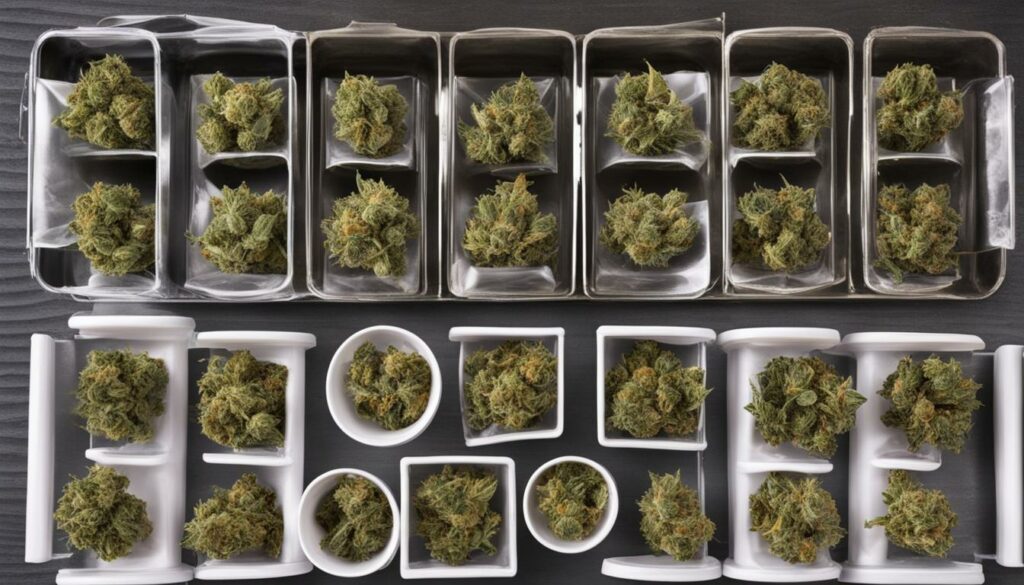
How Long Does Curing Cannabis Take?
The time required for curing cannabis can vary depending on several factors, including humidity levels, temperature, and the type of containers used for curing. On average, the curing process takes between three weeks to six months. However, it’s important to note that patience is key when it comes to curing cannabis, as a slow cure often yields better flavors and aromas.
During the curing process, it is essential to regularly check the buds and use the “Branch Bending Test” to determine if they are fully dry. This test involves gently bending a small branch to see if it snaps instead of bending. If the branch snaps, it indicates that the buds are dry and ready for the next stage of the curing process.
Keep in mind that the length of the curing process may also depend on the desired outcome and personal preference. Some growers prefer a shorter cure for a fresher, more vibrant taste, while others opt for a longer cure to develop deeper, complex flavors. Ultimately, the duration of the curing process is a matter of experimentation and finding the right balance to achieve the desired results.
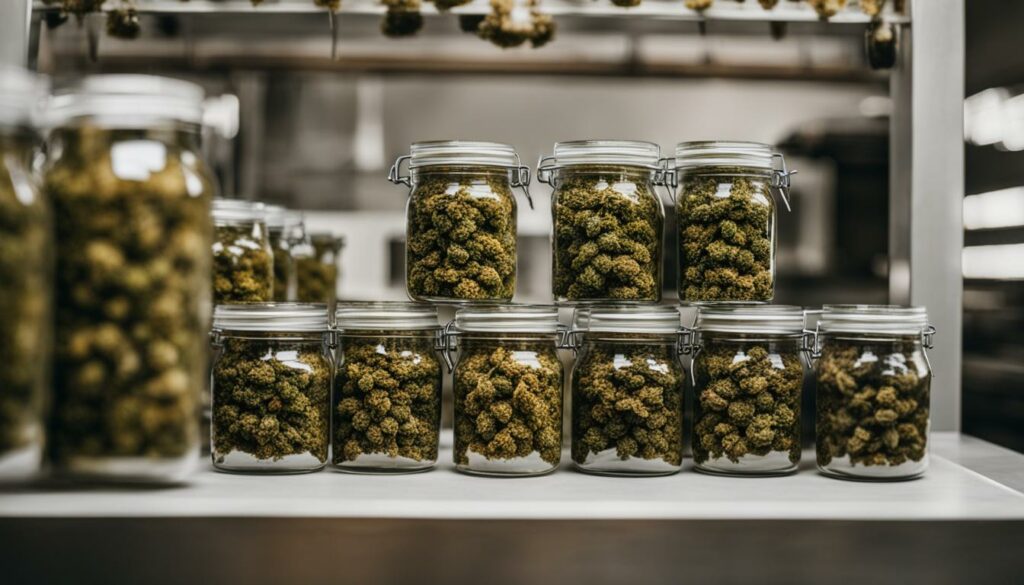
Table: Factors Affecting the Duration of Cannabis Curing
| Factors | Impact on Curing Duration |
|---|---|
| Humidity Levels | Higher humidity levels can prolong the curing process, while lower humidity levels may expedite it. |
| Temperature | Warmer temperatures can accelerate curing, while cooler temperatures may lengthen the process. |
| Curing Containers | The type of containers used for curing, such as glass jars or plastic bags, can influence the curing duration. |
| Bud Density | Denser buds may require a longer curing period to allow moisture to evenly distribute throughout the flowers. |
Cannabis Curing Techniques: Automation in the Curing Process
The cannabis industry has seen significant advancements in cultivation techniques, and curing is no exception. With the increasing demand for high-quality cannabis, many large-scale growers are turning to automation to streamline the curing process.
One popular automated solution is the use of auto-curing buckets. These food-grade, airtight containers come equipped with air pumps that regulate the internal environment. The controlled airflow helps maintain optimal humidity levels and reduces the need for manual burping, making it an efficient option for curing larger quantities of buds.
Commercial growers also have access to specially designed curing technologies that offer precise control over humidity, temperature, and airflow. These systems provide consistent and reliable curing conditions, ensuring that each batch of buds is cured to perfection.
The Benefits of Automation
Automating the curing process offers several advantages. Firstly, it allows for greater consistency in curing conditions, which helps produce uniform batches of high-quality cannabis. By eliminating the need for manual intervention, automation minimizes the risk of human error and ensures that each bud is treated with the same care and precision.
In addition, automation saves time and effort for growers. The automated systems monitor and regulate the curing environment, reducing the need for constant monitoring and adjustment. This frees up valuable time for growers to focus on other aspects of cultivation, such as harvesting and trimming.
Benefits of Proper Drying and Curing
Properly drying and curing cannabis buds is essential to optimize the aroma, flavor, potency, and lifespan of the product. The drying process removes excess moisture, allowing the buds to develop their desired texture and consistency. Once dried, the curing process begins, which involves storing the buds in a controlled environment to further develop their flavor profile and potency.
Curing cannabis is a delicate process that requires attention to detail. During curing, the buds undergo chemical changes that enhance their taste and smell. The breakdown of chlorophyll and sugars reduces the plant-like taste and results in a smoother smoke. Additionally, terpenes, the compounds responsible for the distinctive aromas of different cannabis strains, are preserved through proper curing, ensuring a more enjoyable experience for consumers.
In addition to flavor and aroma, proper drying and curing also help preserve the potency of the buds. Cannabinoids, such as THC and CBD, are susceptible to degradation when exposed to light, heat, and oxygen. Curing in a dark and controlled environment minimizes these factors and allows the cannabinoids to remain intact, ensuring a potent and long-lasting product.
A well-dried and properly cured cannabis bud can retain its potency, flavor, and aroma for an extended period. When stored in an airtight container away from light, heat, and humidity, the cured buds can last for a year or even longer, maintaining their quality and effects. This allows consumers to enjoy their cannabis at their own pace and ensures that growers can provide a consistent product that meets the expectations of their customers.
Table: Key Benefits of Proper Drying and Curing
| Benefits | Description |
|---|---|
| Enhanced aroma and flavor | Proper drying and curing develop the terpene profile, resulting in more enjoyable flavors and aromas. |
| Preserved potency | Cannabinoids are protected from degradation, ensuring the buds maintain their desired effects. |
| Reduced plant-like taste | The breakdown of chlorophyll and sugars during curing minimizes the undesirable plant-like taste. |
| Extended shelf life | Well-dried and cured buds can last for a year or longer without significant degradation in quality. |
Related Articles
- When Is the Best Time to Harvest Cannabis for Optimal Potency?
- How to Dry and Cure Cannabis for Maximum Flavor?
- What Are the Signs That Your Cannabis is Ready to Harvest?
- How Does Curing Affect the Quality of Cannabis Buds?
- What Are the Common Mistakes to Avoid in Cannabis Curing?
Conclusion
Properly curing cannabis is an essential step in the cultivation process to achieve the highest quality buds. By maintaining optimal conditions such as humidity levels, temperature, and darkness, you can enhance the aroma, flavor, potency, and shelf life of your cannabis.
Whether you choose traditional methods like jar curing or explore automation options, attention to detail and patience are key. Remember to monitor humidity and temperature closely, and use the “Branch Bending Test” to ensure your buds are fully dry.
By following these guidelines on how to cure cannabis properly, you can enjoy smokable, flavorful, and potent buds that will last for a year or even longer without significant degradation. So, take the time to give your cannabis the care it deserves, and you will be rewarded with a truly exceptional product.
FAQ
What is the importance of curing cannabis?
Curing cannabis is crucial for enhancing aroma, flavor, potency, and extending the shelf life of the product. It also helps retain cannabinoid levels and breaks down sugar and chlorophyll for a better smoking experience.
What are the optimal conditions for curing cannabis?
The optimal conditions for curing cannabis include maintaining humidity levels between 50%-60% and a temperature of 60°-70° F. The curing room or container should be dark, cool, and dry to protect the buds.
How should cannabis be dried before curing?
Cannabis can be dried using either wet trimming or dry trimming methods. Wet trimming involves trimming the buds immediately after harvest, while dry trimming involves letting the plants dry before trimming.
What is the process of hang drying cannabis?
Hang drying is the most common method for drying cannabis buds. The plants should be hung upside down in a cool, dark, and well-ventilated area with a temperature of 60-70°F and humidity levels between 55-66%.
How does jar curing cannabis work?
Once the buds are dried and trimmed, they should be loosely placed in airtight containers, such as glass jars, filling them about three-quarters full. The jars should be stored in a cool, dark place with humidity levels between 55-65%.
Why is monitoring humidity and temperature important during the curing process?
Monitoring humidity and temperature is crucial to create the best conditions for curing cannabis. Humidity levels should be kept between 45-65%, and temperature should be around 21°C/69.8°F to prevent mold growth and degradation of the buds.
What is the difference between wet trimming and dry trimming?
Wet trimming involves trimming the buds immediately after harvest, while dry trimming involves letting the buds dry before trimming. Wet trimming is easier but can lead to trichome loss, while dry trimming preserves trichomes but is more labor-intensive.
How long does the curing process take?
The length of the curing process can vary from three weeks to six months. Factors such as humidity levels, temperature, and curing containers can affect the time required for optimal curing.
Are there automation options for the cannabis curing process?
Yes, for large-scale growers, auto-curing buckets and specially designed curing technologies are available to automate the curing process, allowing for the curing of larger quantities of buds and controlled airflow.
What are the benefits of proper drying and curing?
Proper drying and curing preserve the terpenes and cannabinoids in cannabis buds, resulting in improved aroma, flavor, potency, and shelf life. Well-dried and cured cannabis can last for a year or longer without significant degradation.
How to cure cannabis properly?
To cure cannabis properly, it is important to maintain optimal conditions, including humidity levels between 50%-60%, temperature of 60°-70° F, and storing the curing containers in a dark, cool, and dry place. Additionally, regular monitoring of humidity and temperature is essential.



